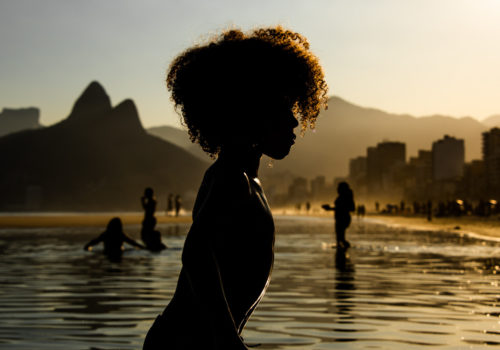Sandra Cattaneo Adorno is one of those artists who gained international attention and fame following a first career in a different field. Having launched her photography career at age 60, she is currently charming the Venetian audience with her first solo exhibition featuring works from Scarti di Tempo and Águas de Ouro as part of the group show Personal Structures. To dive a little deeper into her fantastical world and learn more about the metaphors and elements she grew up with, we recently spoke about “what’s new” and what’s on view.
Nadine Dinter: You recently published your latest photo book, Scarti di Tempo [scraps of time], and those works are currently on view in Venice. How long did it take you to create the book, and how long to curate the show?
Sandra Cattaneo Adorno: I started working on the photographs for the book at the start of the pandemic, around March 2020. The book was printed in April 2022, so it took me two years to create it. As far as the exhibition is concerned, my team and I prepared it in six months.
To what extent did the pandemic impact the atmosphere of the images in Scarti di Tempo? What was the main impulse for this project?
SCA: I got the idea for Scarti di Tempo while printing my book Águas de Ouro [waters of gold]. The way the photos combined and overlapped on the metallic plates, which printers call scarti, meaning “scraps” in Italian, prompted me to experiment with my photos. When the lockdown started, I had more time to work on my archive and use past images to create composites for the book. I believe that a sense of self-reflection and perhaps a dreamlike quality permeate Scarti di Tempo – sparked by the feeling of immobility caused by the pandemic.
Your other series, Águas de Ouro, is also on view as part of the show Personal Structures. The poetic images you shot in your native Rio de Janeiro reflect the sensuality, warmth, and spirit that stand for the Brazilian way of life, known as saudade. Tell us about the places you revisited, what time of the day you took the images, and memorable moments you encountered during your shoot.
SCA: In Águas de Ouro, I wanted to explore my childhood memories of Rio, so I revisited Ipanema, the beach where I used to go with my family. I went there mostly at sunset to try and capture the beautiful light that, as you said, helps to create a more poetic mood in the photographs. The most special moments for me were the ones when I saw children playing, as they reminded me of myself as a little girl.
How does Aguas de Ouro differ from Scarti di Tempo, and how are they similar?
SCA: In Scarti di Tempo, I mainly worked with reflections, while in Aguas de Ouro, I concentrated on silhouettes. That’s a big difference for me, as it represents a move towards a freer approach to photography than what’s offered by traditional street photography. In both projects, however, I think that I created dreamlike images that could convey my state of mind at the time and my ideas for the projects.
In Venice, characteristics such as the blue-green lagoon, the brilliant sun over the Canale Grande, the red rooftops of the various districts, and the white marble play a role in the image of the city. Do you see any parallels to the colors of Brazil that you encountered at Ipanema Beach?
SCA: The colors and the atmosphere in Venice and Ipanema can be quite different, as everything is somehow more intense in Rio. However, I like to think that the presence of the water acts as a link between the two places, particularly in the way it reflects the light and hints at something hidden and mysterious.
At the age of 60, you decided to pursue a career in photography. What did you do professionally before that?
SCA: I was working in my family business – for a long time, I never really thought I could do anything creative.
How was the reaction to your works in Venice? Could people relate to it? When you were in Venice, did you find inspiration and time to photograph on site?
SCA: I received very positive feedback from the people who visited my exhibition, which was really encouraging and humbling. When I was there, I was also able to experiment a little with my photography, and I managed to get a few fun shots while entertaining family and friends.
What is your next project about? Will this show be traveling elsewhere?
SCA: I am focusing on the promotion of Scarti di Tempo at the moment, which will be officially launched at Paris Photo in November this year. I am also preparing an exhibition at the Brazilian Consulate in New York.
Do you think that the feeling of saudade can be explained in a different language or applied to another culture?
SCA: It is a very complex feeling that is deeply embedded in Brazilian culture. I like to think that it is something unique that unites us and creates connections between people.
What is your advice for women photographers?
SCA: I think that to experiment and enjoy shooting are the most important things. As far as women photographers are concerned, I think it is important for us to come together, feel part of a community, and support each other’s work.
To find out more about Sandra Cattaneo Adorno, please visit: https://www.sandracattaneoadorno.com/
or follow Sandra at @sandracattaneoadorno
The show:
through November 27, 2022 at Palazzo Mora in Venice, curated by Gulnara Samoilova
The book:
Scarti di Tempo, published by Radius Books | Hardcover | 9.75 x 13 inches | 62 images | 148 pages ISBN: 9781942185994 | $60 | Pub Date: July 19, 2022
















